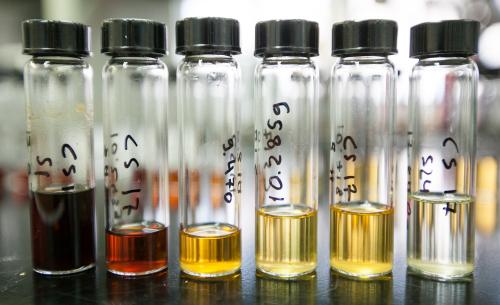Science:美国科学家研发出一种将糖诱导出来技术以促进生物燃料
威斯康星大学麦迪逊分校化学与生物工程学院的一项新研究报告,得益于一种将糖从干的植物性物质中诱导出来的新技术,用生物燃料取代日益减少的以石油为基础的燃料来源的工作可能会变得容易一些。相关文章发表于2014年1月17日的《science》杂志上。

science:美国科学家研发出一种将糖诱导出来技术以促进生物燃料发展
由于油价的上涨,像生物燃料这样的替代能源已经变得日益流行。生物燃料是通过将稳定植物细胞壁的纤维素中的糖进行发酵而制备的,但这些糖首先必须得进行释放,而这是非常困难的。特定的酶可对这一过程有帮助,但科学家们需要想出更多的方法将纤维素分解糖。
现在,Jeremy Luterbacher及其同事已经做到了这一点。他们报告了可从在玉米秸秆、硬木和软木的纤维素和半纤维素中高效地产出葡萄糖。为了实现这一壮举,他们将来自以上这些来源的干性植物物质放入到了GVL中——GVL本身就是一种生物燃料,且这组研究人员在以往的研究中已经证明了GVl能够降解生物质。他们只是在GVL中加入了适量的水与酸并将这些化合物分解成为葡萄糖—这是用于发酵的燃料。
至关重要的是,这些葡萄糖并没有被降解——葡萄糖被降解是使用其它方法遇到的一个问题——而是为发酵过程完整地留了下来。该小组的经济模型表明,该整个过程就其成本而言可与当前的从生物质中生产乙醇的方法竞争。
原文摘要:
Nonenzymatic Sugar Production from Biomass Using Biomass-Derived γ-Valerolactone
Jeremy S. Luterbacher, Jacqueline M. Rand, David Martin Alonso, Jeehoon Han, J. Tyler Youngquist,Christos T. Maravelias, Brian F. Pfleger, James A. Dumesic
Widespread production of biomass-derived fuels and chemicals will require cost-effective processes for breaking down cellulose and hemicellulose into their constituent sugars. Here, we report laboratory-scale production of soluble carbohydrates from corn stover, hardwood, and softwood at high yields (70 to 90%) in a solvent mixture of biomass-derived γ-valerolactone (GVL), water, and dilute acid (0.05 weight percent H2SO4). GVL promotes thermocatalytic saccharification through complete solubilization of the biomass, including the lignin fraction. The carbohydrates can be recovered and concentrated (up to 127 grams per liter) by extraction from GVL into an aqueous phase by addition of NaCl or liquid CO2. This strategy is well suited for catalytic upgrading to furans or fermentative upgrading to ethanol at high titers and near theoretical yield. We estimate through preliminary techno-economic modeling that the overall process could be cost-competitive for ethanol production, with biomass pretreatment followed by enzymatic hydrolysis.

